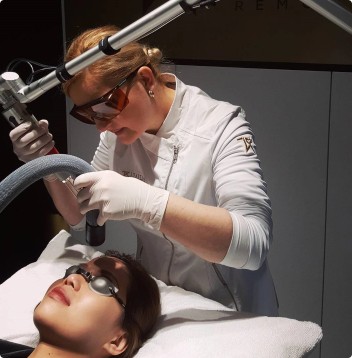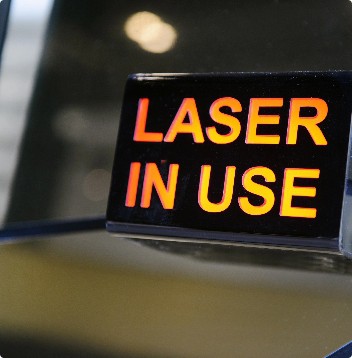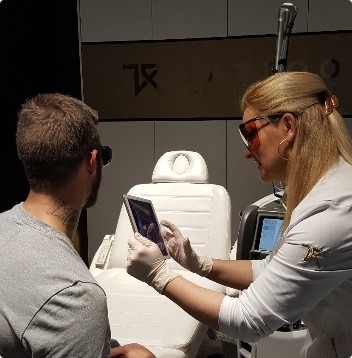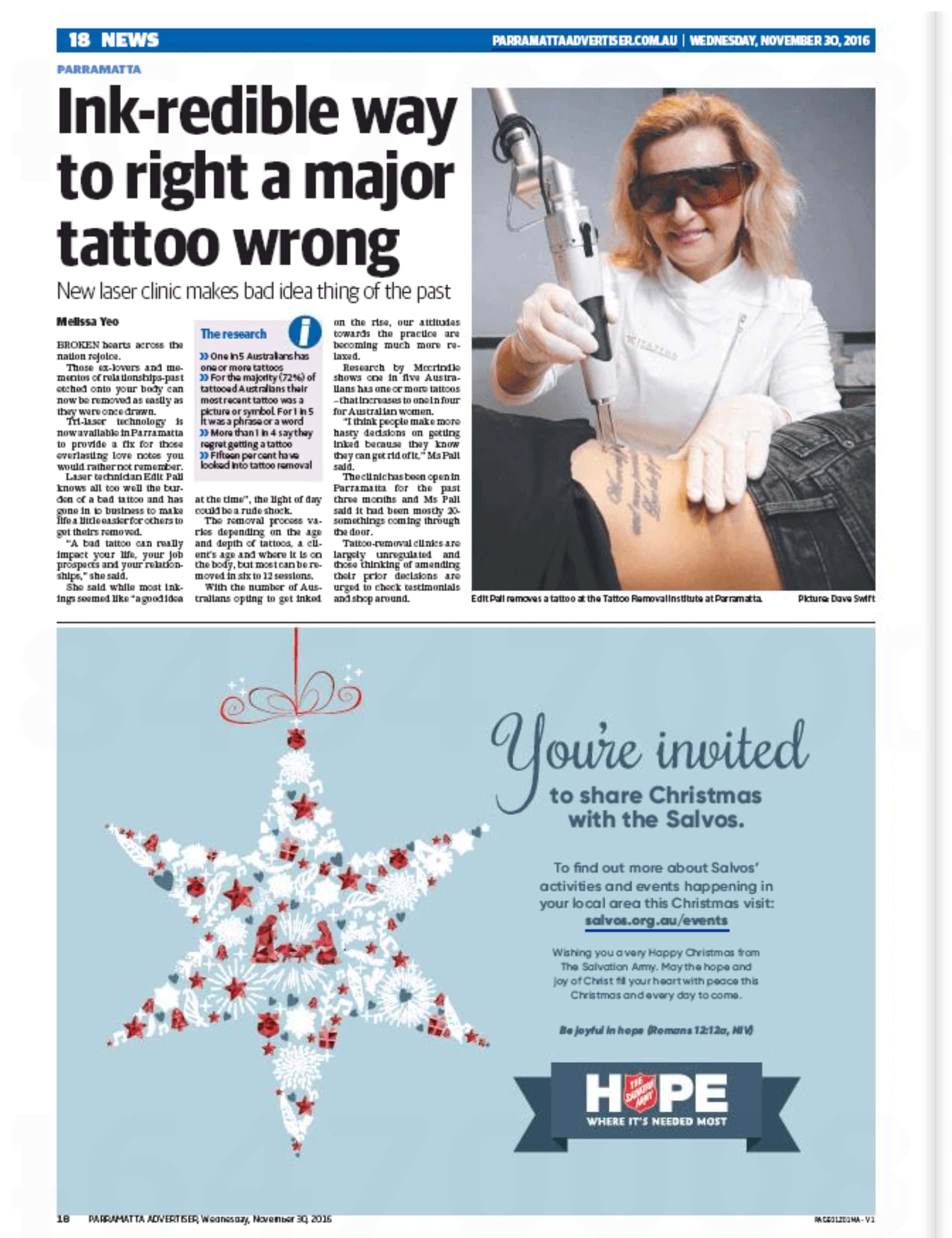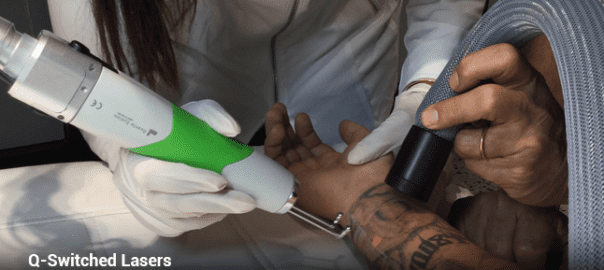Because everyone’s skin and unwanted tattoos are different, the laser tattoo removal healing process will look different for everyone too.
It’s important to know what to expect with tattoo removal, so that you’re not caught off guard or worrying that something is wrong when in fact, it’s normal - but it’s also worth knowing what isn’t normal and when you should seek medical attention.
As you should know, most quick fixes in life end up being long-term disasters. Laser tattoo removal is a journey, not a sprint. If you respect the process, you will be rewarded.
We will discuss the laser tattoo removal healing process from:
- immediately after;
- three days after;
- the first week after; and
- the second week onwards.
Immediately After Laser Tattoo Removal Treatment
As the laser sends light energy into the skin, small white bubbles often form on the skin’s surface. This is known as frosting.
During the laser tattoo removal session, the laser light penetrates heat into the skin, causing the tattoo ink pigments to burst and shatter. As this happens, the ink particles release bubbles of carbon dioxide, which rise to the top layer of the skin.
Like with many laser tattoo removal side effects, although unusual, this is a good sign.
Tattoo frosting will last only a few minutes, a maximum of 30, and is an indication that the body’s natural healing process has begun.
Your laser technician will apply laser aid gel to the treated area, followed by a bandage.
On and around the treated area, it is normal to experience:
- swelling;
- redness;
- bruising;
- sensitivity; and
- a warm sensation.
Aftercare Is Crucial with Laser Treatments
The more disciplined you are with your laser tattoo removal aftercare, the quicker and more efficient your recovery process will be.
After your first laser treatment session, you should apply ice packs or cold compress the treated area. The sooner you do this, the smaller the chance is of the skin blistering.
Keep the treatment site elevated if possible.
Although showering is permitted, try as much as possible to keep the treated area dry. Change your dressing or bandage daily and apply antiseptic ointment at least three times a day.
The First Three Days After Laser Treatment
Continue applying ice or cold compresses to the skin. Nurofen can aid with swelling and inflammation. You can also take Tylenol if you are experiencing pain.
Be disciplined in applying antiseptic cream and keeping the area clean and fresh. Even though the skin might feel tender or tingly, don’t fiddle with the bandage as it can irritate the skin.
At this point, you might experience itching. Itching is an indication that the body is going through the healing process. It could also mean that blisters are busy forming. Regardless, resist the urge to itch and scratch on or around the treated skin.
Take note that tattoo removal blisters are a completely normal side effect. Try your best not to scratch or pop them as this could lead to infection.
The First Week After Laser Removal
After the first three days, you can keep the bandage off to allow the treated skin to breathe.
You might still experience redness and swelling, and this is completely normal. Try your best not to bump or scratch the area as it will still be sensitive and not as protected without the bandage. Bumping the blisters can also result in them popping.
The fluid in the blister is there to protect and heal the skin. If the blisters pop, it can cause the skin on top to rip off if not properly taken care of. Allow the blisters to go down and dry out naturally and form scabs. The scabbing process is important to reduce the risk of bacteria entering and causing infection.
Do not pick off the scabs, as this could lead to scarring. Apply vitamin E oil to soothe the skin, and continue to apply an antibacterial ointment.
If the blisters are oozing a pus-like substance rather than a watery one, seek medical attention.
From the Second Week Onwards After Tattoo Removal
You can expect all your symptoms to become milder and milder with time.
You might notice the treated skin looking darker as the pigment rises to the surface of the skin. The area around it might lighten (hypopigmentation) or darken (hyperpigmentation) too. This is completely normal and will fade with time.
Continue the aftercare as instructed.
Even if you feel fully recovered and ready for your next laser removal session, don’t do so prematurely.
How Long Is the Tattoo Removal Healing Process Before You Can Book Your Next Treatment Session?
Most patients require six to eight weeks between laser tattoo removal sessions.
This is because the body’s immune system needs sufficient time to do its job.
During your treatment session, the laser technology pulses light energy into your skin to cause the ink particles to explode. Your body’s immune system sends white blood cells to collect the excess ink particles and remove them for excretion.
Tattoo ink particles are too large for the white blood cells to pick up, and that’s why we use laser therapy to break them down into smaller and smaller particles. Every session breaks them down even more until the immune system has got rid of every last one.
This process occurs every time you undergo treatment, so the body needs adequate time to recover each time.
Having treatments too close together can encourage the body to adapt and make treatment less effective.
By the time your tattoo is 70% faded, sessions could space out to ten to twelve weeks apart, depending on how the body is healing and rejecting the ink. At this point, your body needs more time to reject the ink as the skin is more sensitive.
There are many factors that come into play as to how long your laser tattoo removal process will take before complete removal.
You can speed up the tattoo removal healing process by eating a diet rich in fresh fruit and vegetables, keeping hydrated with lots of water, avoid sun exposure directly on the treatment site, and avoid smoking.
After a Few Laser Tattoo Removal Sessions
As you go through the laser tattoo removal process, you might experience hyperpigmentation or hypopigmentation.
These are skin discolourations that occur around the treated area in the form of patches of skin, either lighter or darker than your normal skin tone. They occur because your body overproduces melanin or underproduces it as a response to the laser treatment.
This is normal, and generally, these go away with time over the laser tattoo removal healing process.
A Successful Tattoo Removal Healing Process Is Up to You - and Your Laser Technician
If you follow aftercare instructions correctly after each laser treatment session, the removal process will be over before you know it. It will take time for your immune system to do its thing and for your unwanted tattoo to be completely healed, but the more efficient you are with your aftercare, the better the recovery process will be.
Before choosing the tattoo removal clinic to do your laser treatment sessions, do your research. Find out whether they are using the latest laser technology and whether the removal technician is appropriately certified. Take a look at the reviews on their site and those on Google and other platforms.
At the Tattoo Removal Institute, we offer a free consultation with no strings attached. Come for a look and feel of the place, chat with our professionals, and ask any questions you might have before agreeing to anything.
Key Takeaways
Various side effects can be expected along the process of your laser tattoo removal journey.
Being educated on what to expect along the way can put your mind at ease and prepare you to identify anything unusual and seek medical attention.
While your immune system plays a big part, you need to allow your body enough healing time between laser treatment sessions.
Don’t be shy to visit different clinics and meet the laser technicians. Ask questions and find a laser tattoo removal clinic you feel comfortable and confident with. Contact the Tattoo Removal Institute today to book your free initial consultation.
DISCLAIMER: The information contained herein should NOT be used as a substitute for the advice of an appropriately qualified and licensed physician or other health care provider. The information provided here is for informational purposes only. Please check with a physician if you have health questions or concerns about interactions or go to the TGA for a comprehensive list of TGA warnings. Although we attempt to provide accurate and up-to-date information, no guarantee is made to that effect.

